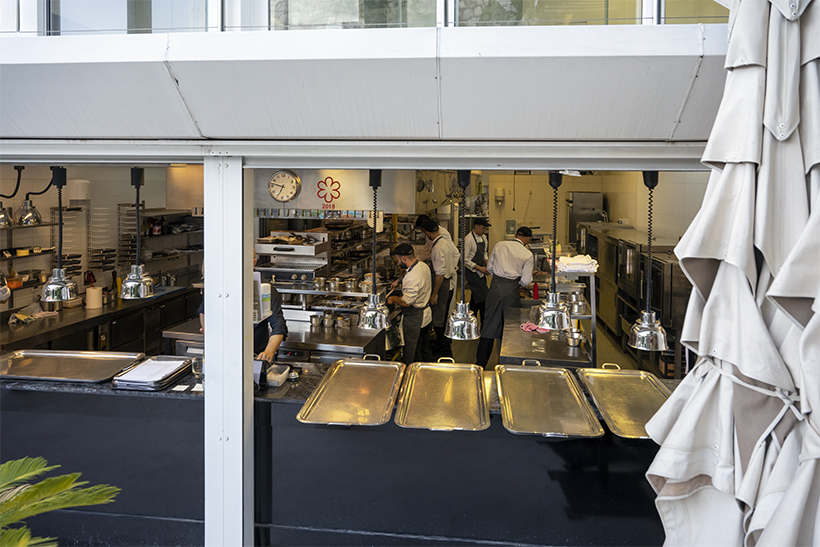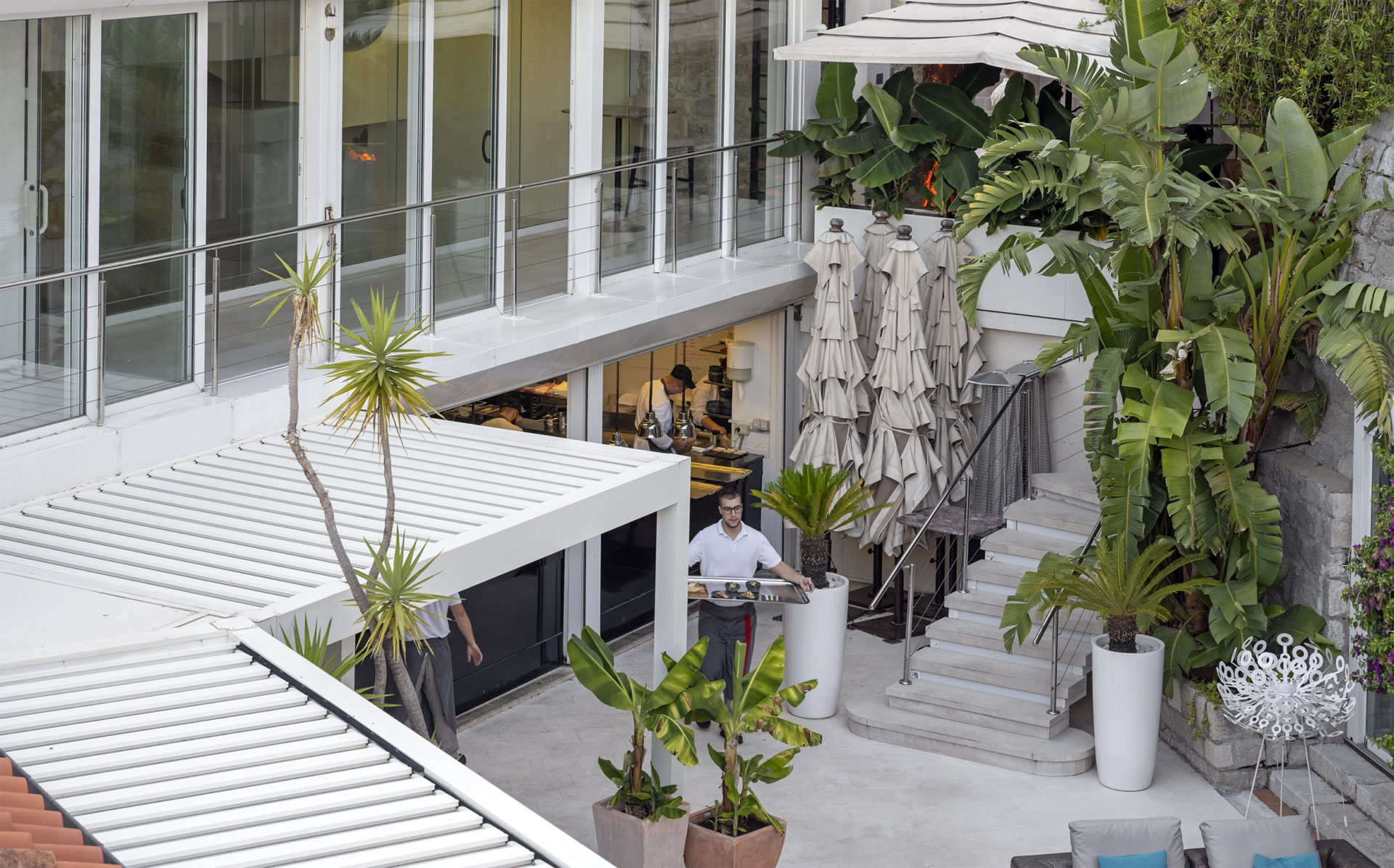Continuing our exploration of Croatia’s stars (according to the Bibendum), we’re leaving Korčula and heading further down the Dalmatian coast to Dubrovnik…
The Old Town of Dubrovnik is ridiculously beautiful, so much so that it became a UNESCO world heritage site in 1979. The defensive stone walls that surround it, considered one of the great fortification systems of the Middle Ages, provide what might be the best views, thanks to their elevation. Now imagine yourself dining outside, right on these historic town walls, protected from the immense flow of tourists, looking out upon both the town and its port. This has to be a tourist trap, right? The kind of place where you sip below-average cocktails for thirty bucks a pop while pseudo-DJs blast bad pop out of huge speakers, and/or where the menu doesn’t list prices and an 18% gratuity is automatically added to all checks, right?
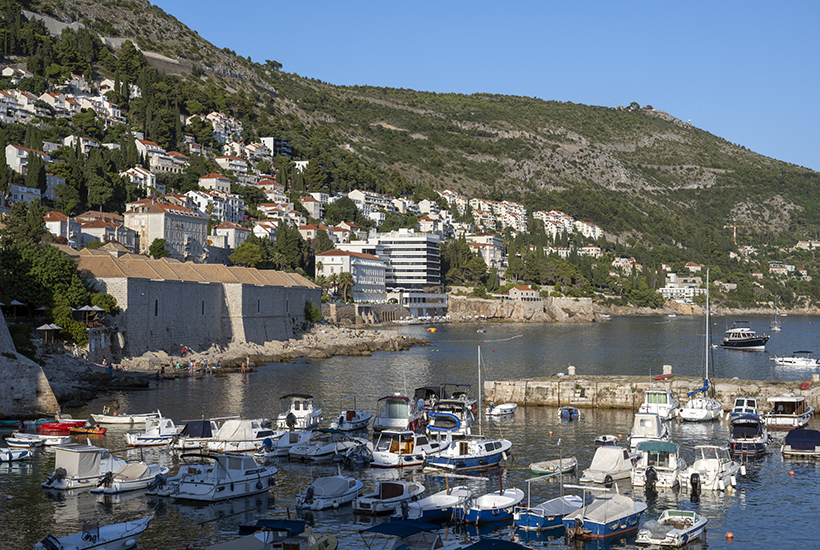
Wrong. Restaurant 360 is a bona fide Michelin star restaurant, and while it may not be within the reach of all budgets, there’s certainly nothing below average in what it serves its patrons. Instead, you can expect Dalmatian classics revisited with modern techniques and a French cuisine influence (very much in line with Food Perestroika’s manifesto!), created by chef Marijo Curić.
Born and raised in Dubrovnik, Curić chose to follow in his father’s footsteps and become a cook. He received his culinary school diploma in 2006 and began to work in kitchens at 17. A couple years later, he joined what is now Restaurant 360 as a sous-chef to French chef Gilles Camilleri (back then, the restaurant was named Gil’s). Camilleri’s departure in 2012 led to a rebranding of the restaurant with its current name, and Curić became executive chef in 2015. When not working in Dubrovnik, Curić also trailed in fine dining restaurants across Europe, from Enrico Bartolini‘s Devero in Milan to Alain Ducasse’s Le Meurice in Paris, as well as several high-end eateries in London.
All the hard work paid off: in 2018, Curić and his team at Restaurant 360 earned a Michelin star, which they’ve kept ever since. The beverage side of the house wasn’t left out, and with its wine list of over 450 labels (including 70+ wines by the glass), the restaurant has also received a Wine Spectator Best of Award of Excellence.
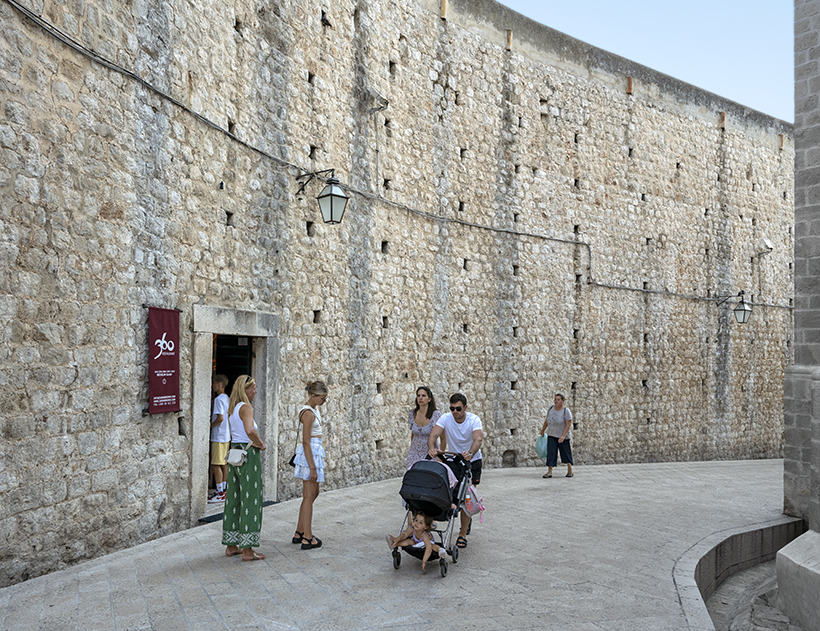
Curić explains that he arrived at his personal style by incorporating the heritage of Austrian-Hungarian cuisine from inland Croatia and Venetian-inspired traditions from the Croatian coast, and blending with some Ottoman legacy, while drawing on French styles and techniques. An avid fisherman, he also gives seafood pride of place on his menus. It’s time to see what it means in practice!
As of my summer 2022 visit, the restaurant serves two tasting menus of seven courses each: a “new” menu consisting of dishes that the chef created for the current season, and a retrospective menu featuring the “best” dishes ever served during Curić’s tenure. Diners also have the option of ordering à la carte to compose their own three or four course prix-fixe.
We were lucky enough to try both tasting menus (my partner one, and I the other), and I will describe them in parallel, reporting for each course first the retrospective plate, then the 2022 plate. Add to this the two different sets of wine pairings, and that’s a lot of eating and drinking!
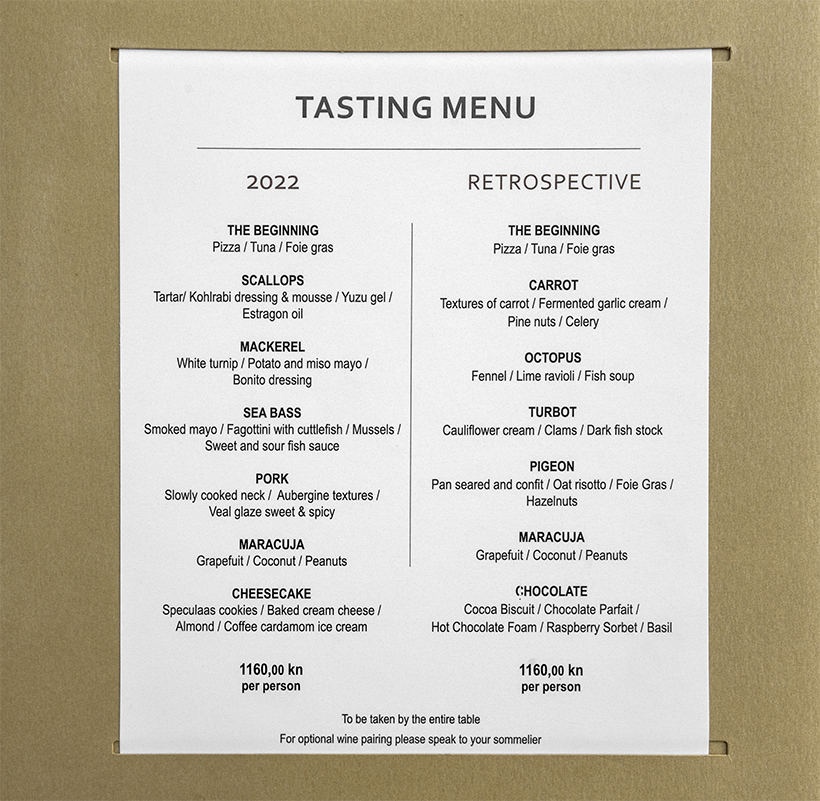
The beginning – Pizza / Tuna / Foie Gras
Common to both menus, this amuse-bouche consists of three little bites: an excellent little pizza with sundried tomatoes, burrata, and black truffles (very flavorful for summer truffles) on a crispy layered pastry; a tuna tartare with wasabi cream and bacon on a tartlet base; and a slice of airy foie gras mousse on a pepper biscuit, topped with sherry glaze. All three preparations are very classic but shine thanks to their fragrant flavors, and they help set the stage for Curić’s cooking style, that mix of Italian, Adriatic, and Austro-Hungarian influences.
We’re also served an assortment of homemade breads – variations on ficelle, focaccia, white crescent roll, and whole wheat roll – and three colorful (salted) butters of basil pesto, red beet, and porcini mushroom. The breads are excellent and the butters all taste like their announced ingredients. We’re off to a good start.
There is no wine pairing with this course, which gives one the chance to order a cocktail or a glass of bubbly, in case one is worried that the five glasses of wine to come won’t be quite enough. My Croatian bubbly, from a winery near Zagreb, fulfills its mission adequately, providing a nice apéritif to enjoy while admiring the view, though without leaving any long-lasting impression.
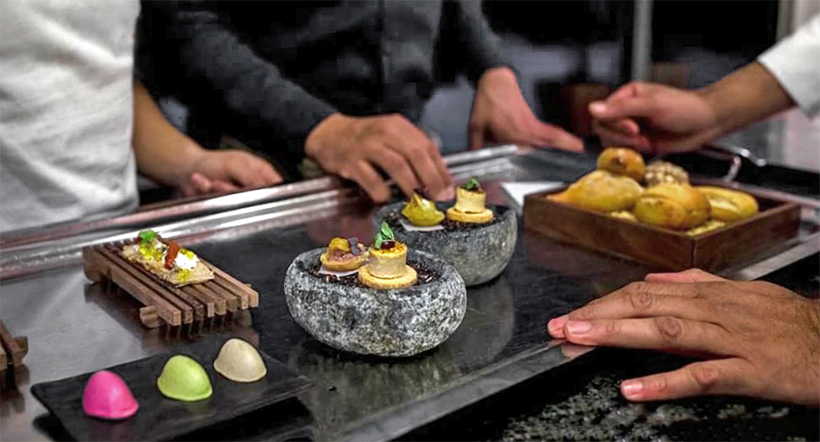
Carrot – Textures of carrot / Fermented garlic cream / Pine nuts / Celery
The carrot textures, though well executed, are all kind of expected. There’s a delicious carrot purée, an equally successful carrot cooked in its own juice, a pickled one, and a dehydrated one that looks like a cracker, accompanied by toasted pine nuts, a celery salad, and a purée of black garlic. As good as all of this is, at the end of the day it’s just carrot, not something one gets overly excited about.
For our first wine pairing, we’re getting a biodynamic rosé made from Cabernet Sauvignon by the Batič winery in Slovenia. While the Cab certainly provides nice red berry notes to the wine, it’s a pretty typical rosé. (Repeat after me, people: 99% of rosé sucks.) Yet the pairing is carefully crafted: carrot, nuts, red berries… It’s probably no coincidence that raspberry and cooked carrot contain floral flavor compounds from the same family.
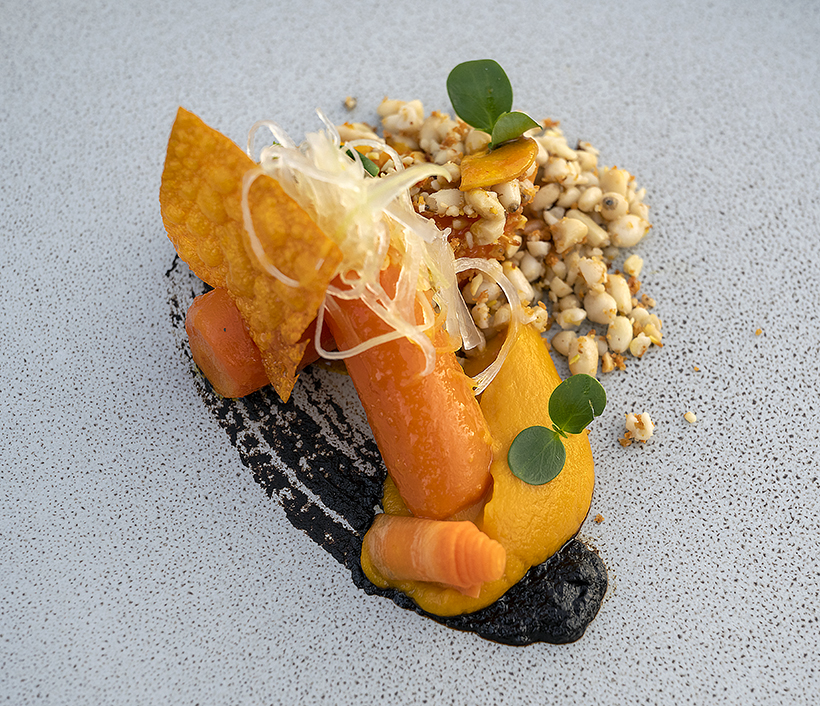
Scallops – Tartare / Kohlrabi dressing and mousse / Yuzu gel / Tarragon oil
The scallop tartare combines sweet and sour tastes (the kohlrabi, the yuzu) as well as soft and crunchy textures (the two kohlrabi preparations, the scallops, the chicken skin chips on top). I’m usually not crazy about kohlrabi, but it goes pretty well with scallops. A very enjoyable plate overall.
This is paired beautifully with a 2019 dry Riesling from the Kopjar winery in northern Croatia, the country’s coldest region – fresh, fruit-forward, and quite mineral.
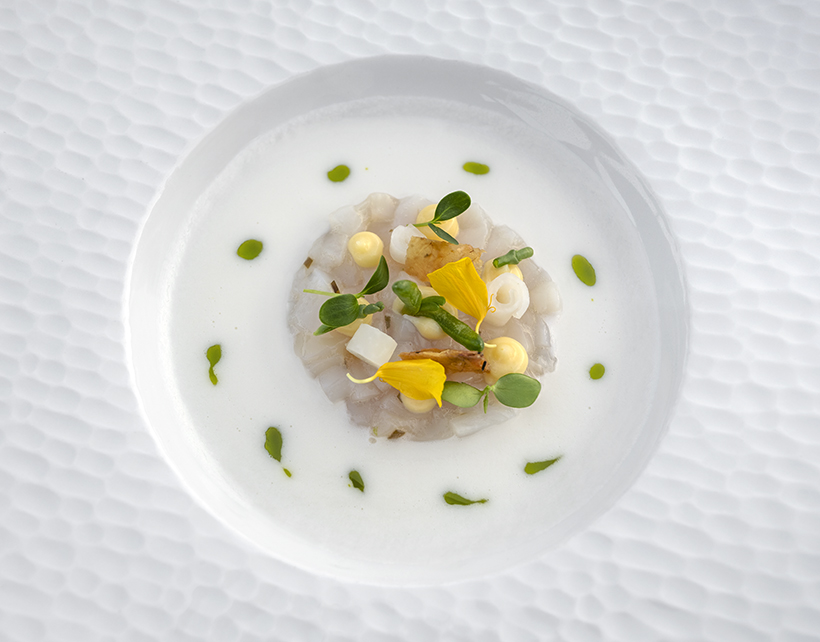
Octopus – Fennel / Lime ravioli / Fish soup
Now, this dish is truly excellent. The octopus is slowly cooked sous vide to make the tentacles as tender as possible; the texture is meaty but very soft and not rubbery at all. The thick fish soup boasts condensed seafood flavors without being aggressive. It hides a creamy fennel purée at the bottom of the bowl, and there’s a glazed wedge of fennel too. Then we have the “lime” ravioli, cooked al dente, whose contents are a bit of a mystery: I taste a lime cream of some sort, but what else? Polenta? Cheese? Very interesting texture, in any case.
The wine is a Maraština, an indigenous white varietal that’s common along the whole Croatian coast because it can resist harsh conditions. This particular wine, a 2021 vintage, comes from the Ante Sladić winery, located in Skradin next to the famous Bibich winery (more on that in another post). The grapes are harvested quite late and the wine is aged in acacia barrels. This is a fruity wine with a creamy finish meant to complement the fish soup.
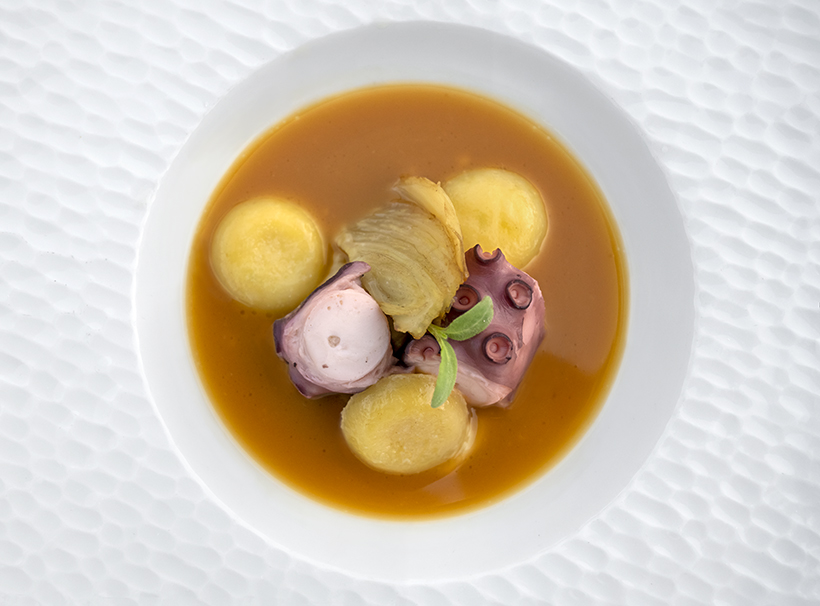
Mackerel – White turnip / Potato and miso mayo / Bonito dressing
Whosoever says mackerel says intense flavors. There’s a filet that’s been smoked and then pan-seared, and some kind of meaty mackerel rillettes. The garnishes include chopped shallots on top of the fish, a sweet and smoky miso mayo on the side, and trout roe in cones made of raw daikon slices that struggle a bit to fit into the rest of the composition. A good dish, but I prefer the octopus.
This too is served with a Maraština, but a different expression made by the Jokić winery, located only slightly further up the coast. This 2019 vintage has more minerality; it’s stony and flinty, to stand up to the mackerel’s flavor. Both Maraština wines are decent choices, but I would have preferred something with more character.
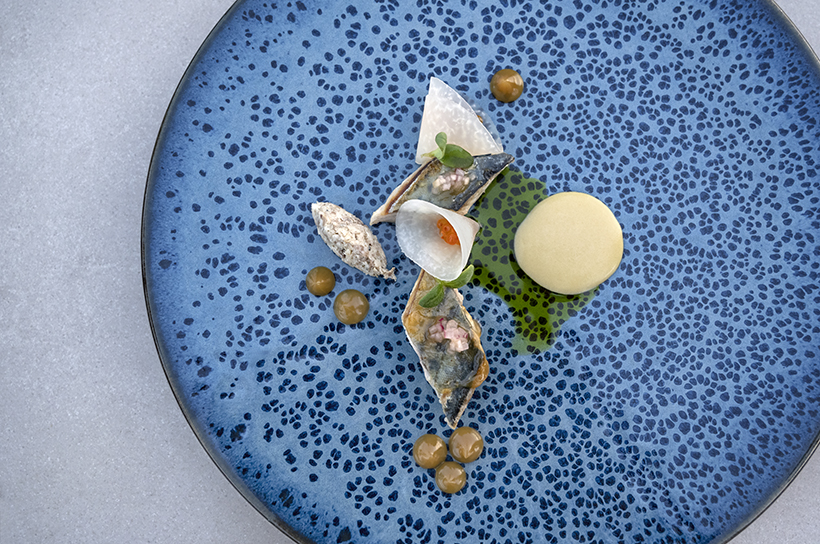
Turbot – Cauliflower Cream / Clams / Dark fish stock
I love turbot and this one doesn’t disappoint. In addition to the oven-roasted fillet (supposedly coated in beurre blanc, though I have some doubts), the beards – the best part! – and some of the bones are turned into cute little breaded bundles. A few littleneck clams complete the seafood landscape. The foamy cauliflower, more like a mousse than a purée, packs an insane amount of flavor. The fish stock/soup seems to be very nearly if not even exactly the same as the one served in the octopus dish, which is a bit strange in a Michelin-star restaurant. But this is another very good dish with a well-thought combination of textures.
As the most delicate of the main courses, this calls for a wine with buttery and toasty aromas: a 2021 Pošip from Korta Katarina winery, made with grapes harvested on Korčula Island. Aged half in oak barrels and half in stainless steel, this wine features a bit more complexity than the typical all-stainless-steel versions made with this varietal (one of Croatia’s most famous indigenous white grapes).
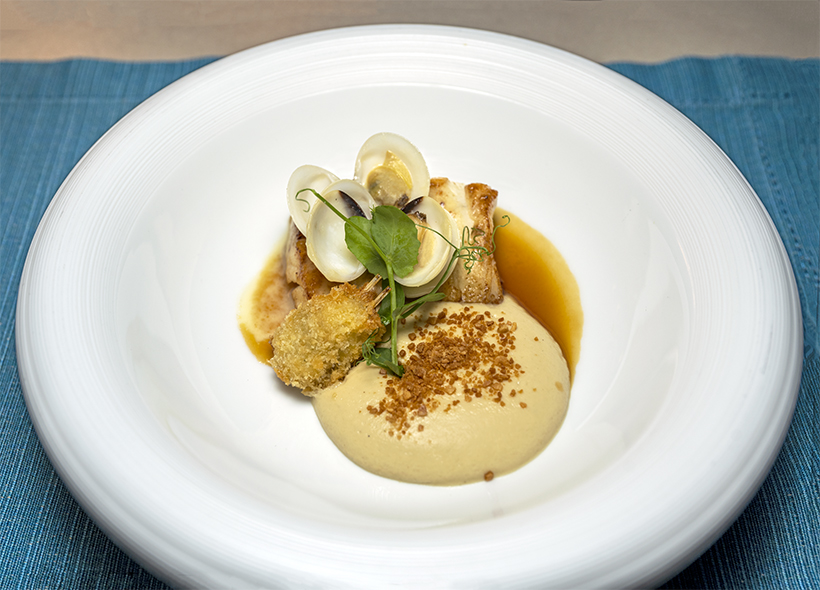
Sea bass – Smoked mayo / Fagottini with cuttlefish / Mussels / Sweet and sour fish sauce
The oven-roasted sea bass is basted with hot oil to make the skin crispy, and this works great: the flesh remains tender while the skin is indeed super crispy. The fillet rests on a bed of clams (which, I assume, replace the mussels announced on the menu), almonds, and sea fennel. It stands face to face with a slightly awkwardly shaped cuttlefish fagottini that doesn’t taste enough like cuttlefish despite the inky black color of the filling. Once again, the sauce reminds me a lot of an earlier one, in this case the sweet and smoky mayo that accompanied the mackerel). Further departing from the written menu description, a spinach pesto sauce seems to replace the fish sauce. Too bad the rest of the dish doesn’t match the quality of the sea bass.
We’re getting another glass of Pošip from Korčula Island, this one a 2019 vintage from Grgić winery (owned by the same family as California’s Grgich Hills Estate). Like Korta Katarina’s, this wine is matured in a mix of stainless steel tanks and oak barrels, but with only 30% of oak. The result is quite similar, with a creamy finish and maybe a touch more fruitiness. Both are very much to my liking.
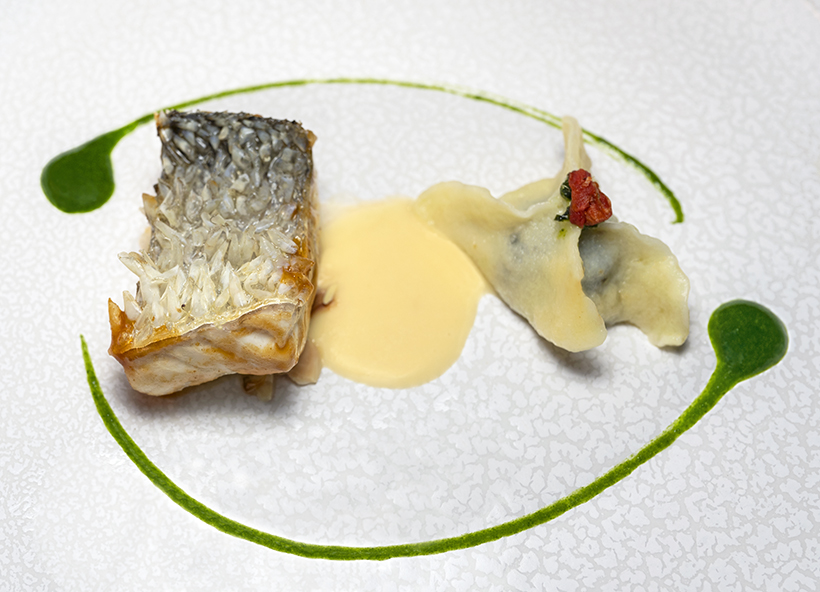
Pigeon – Pan-seared and confit / Oat risotto / Foie gras / Hazelnuts
Drum roll, please! Here comes the obligatory table-finished dish without which a restaurant cannot get a Michelin star! The squab (from Belgium; we’re told that in Croatia “we don’t kill our pigeons, we only feed them”) follows a traditional preparation: a pan-seared breast (slightly undercooked) with a leg and thigh confit. Our server completes the plate by pouring some rather mild squab jus onto it. The bird is otherwise garnished with a too-gruelly oat risotto, thinly sliced mushrooms, a dark cream made of pickled walnuts that’s my favorite thing on the plate, and a small foie gras log rolled in crushed hazelnuts (which seems to have a texture problem). I find the dish to be a strange choice, considering that it’s not really connected to Croatia.
We’re now transitioning to red wine, with a 2019 Pinot Noir called Križevac i Cimbuščak from Korak winery, located in a small hilly area near Zagreb that benefits from cool, foggy mornings. The wine is light and fresh, with notes of strawberry, blueberry, and cherry, and soft tannins. Although I’m usually not crazy about Pinot Noir, I like this one. I really do smell the berries, and I find the wine quite full-bodied for this varietal.
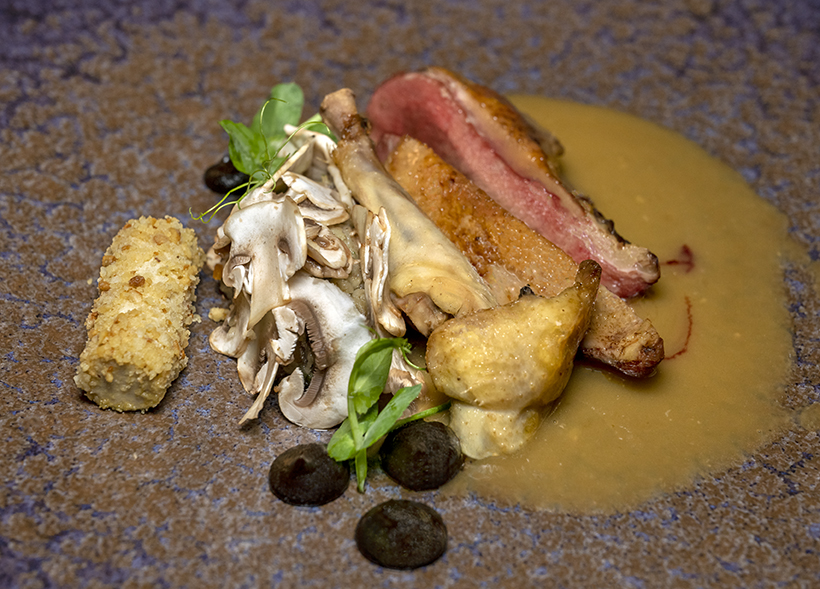
Pork – Slowly cooked neck / Aubergine textures / Veal glaze sweet & spicy
This is another excellent dish. The thick piece of pork neck from Slavonia is cooked sous-vide for 24 hours at 65 C, then pan-seared. The result is tender and moist but with a well-done, pulled pork texture (unlike my pork neck steak that was cooked at a much lower temperature). The meat is topped with pork jus and fresh spring onion, cucumber, and pork crackling. On the side, we have two textures of eggplant: a cream that reminds me of eggplant caviar, and pickled batons, with some fried parsley. Both are really well prepared and form a delicious pairing for the pork.
As my partner has asked to forgo red wine, she’s being served a full-bodied white from Volarević vineyard, located in the Komarna – Croatia’s youngest wine region, in southern Dalmatian on the mainland facing the Pelješac peninsula, where the first vines were planted in 2008. The 2020 Dubrovačka Malvasia (a local varietal) could qualify as an orange wine because the juice is macerated with the skins for 150 days, but because the maceration occurs at a controlled temperature, you don’t get the characteristic amber color. This is a rather small production: only one barrel was made! The nose exhibits aromas of dried citrus, quince, and flowers. I can taste a little bit of the funky palate that I associate with orange wines, but its much more subdued. Interesting.
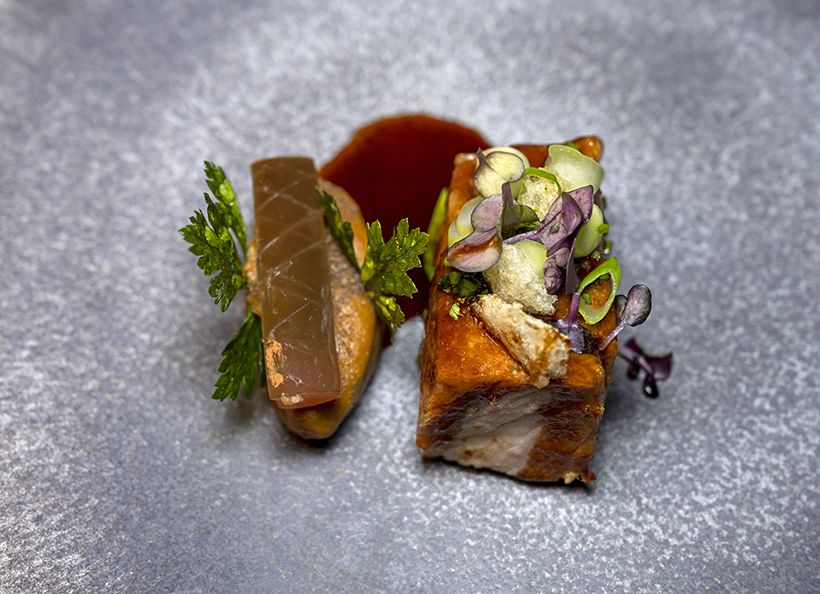
Maracuja – Grapefruit / Coconut / Peanuts
Perhaps this pre-dessert, common to both menus, isn’t the most Croatian dish, but it’s fantastically fresh: a grapefruit panna cotta on an Armagnac gel base, topped with passion fruit ice cream, coconut foam, and mint oil. The grapefruit, passion fruit, coconut, and mint form an amazing ingredient pairing (I can’t taste the Armagnac very much). Some biscuit crumbs sprinkled on the panna cotta add some texture contrast, but I’m not sure what they’re made of – perhaps this is the peanut?
This small plate serves as a palate cleanser, so it doesn’t come with any wine pairing.

Chocolate – Cocoa biscuit / Chocolate parfait / Hot chocolate foam / Raspberry sorbet / Basil
The classic chocolate-raspberry pairing doesn’t make this dessert any less great. Starting from the bottom we have a chocolate biscuit, then a chocolate parfait with raspberry sorbet in its center, covered with warm chocolate sauce, and then a thin chocolate wheel, topped with some fresh raspberries, candied pistachios, red chocolate pearls, green basil gel, and lime zest. All perfectly executed, with the debauchery of toppings bringing some subtle nuances to the flavors of the two main ingredients.
To add even more fruitiness and freshness to this plateful of chocolate, I’m sipping a glass of 2017 San Salvatore Muscat from the Benvenuti winery in Istria. I usually don’t drink dessert wines with dessert dishes, especially chocolate, because it just tastes like adding more sweet to the already sweet, but the concentrated floral notes of this late-harvest muscat are a great complement to the raspberry. And it’s an excellent dessert wine.

Cheesecake – Speculaas cookies / Baked cream cheese / Almond / Coffee cardamom ice cream
So we flew to Dubrovnik from New York to eat a cheesecake… A speculaas biscuit provides a spicier alternative to the traditional graham cracker base, and the toasted and caramelized almonds replace the more common fruit topping. A coffee and cardamom ice cream on a bed of salty almond crumble adds a touch of sophistication that further departs from a slice at Junior’s. Sarcasm aside, it’s a very good dessert.
No Croatian wine pairing experience would be complete without a prošek, the intense raisin wine popular in Dalmatia. The 2015 vintage from Stina comes from the island of Brač and is made from two grapes, white Pošip and red Plavac, in equal proportion. This unusual blend combines the best of both, with aromas of fig, raisin, and dark berries. Yet I’m not sure it goes that well with the cheesecake, because, again, I think that sweet wines and sweet desserts just end up masking each other.
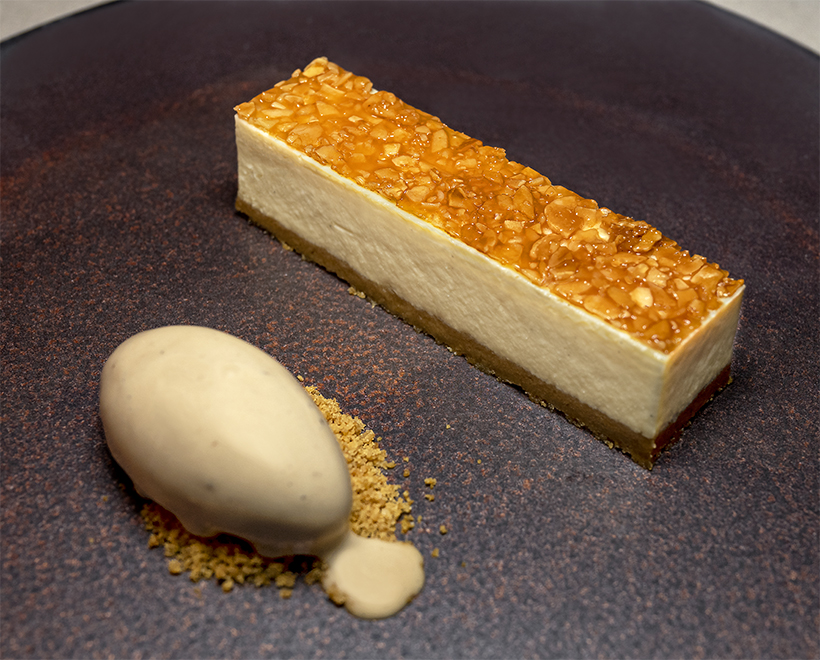
We conclude the meal with an assortment of sweets: a coffee-flavored praline with a salty gel (which reminds me of the Adriatic itself), a passion fruit pâte de fruits (classic), and an Oreo-flavored chocolate with vanilla ice cream inside (why ruin good chocolate with Oreo crumbs?). I didn’t take a picture, sorry.
While I can’t say that I liked one of the two tasting menus more than the other, if I could mix and match dishes from both of them, I could curate a menu in which I’d consider each course truly excellent, and that’s quite an achievement. The other dishes have some minor flaws: the occasional garnish that doesn’t mesh well with the rest of the elements on the plate, the occasional odd choice of main ingredient (the carrot, the pigeon), some similar elements repeated between dishes (the mayos, the fish stocks), the slight deviations from the menu when it would be easy to just print an update. The same can be said about the wine pairings: I wasn’t blown away by every glass I was served, but there were several surprising discoveries. Overall, Restaurant 360 totally deserves its star, and the young chef has plenty of time to work towards a second one.
